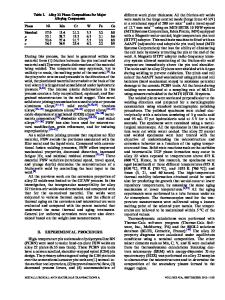Effect of Multi-pass Friction Stir Processing on the Electrochemical and Corrosion Behavior of Pure Titanium in Strongly
- PDF / 2,288,116 Bytes
- 9 Pages / 593.972 x 792 pts Page_size
- 28 Downloads / 266 Views
INTRODUCTION
SUPERB corrosion resistance and high strength to density ratio are the key properties of titanium (Ti) and its alloys, which makes them highly attractive for many industrial and technological applications including chemical process industry and aerospace materials.[1–4] The presence of a spontaneously forming, adherent, self-healing, and very stable passive oxide film on the surface of Ti and its alloys consisting mainly of TiO2 renders them virtually immune to aggressive ions such as chloride and sulfate, highly applicable in many aqueous and atmospheric media, and satisfy their excellent biocompatibility.[5–7] More recently, the corrosion behavior of high strength Ti alloys was improved by minor alloying additives which have broadened their usage in different industrial sections.[1,3] On the other hand, some researchers have argued that severe plastic deformation (SPD) affects the corrosion behavior of Ti and its alloys depending on its resultant alternation of microstructure and grain size. Kim et al. showed that a Ti sample of the tiniest grain size, which was processed by high-ratio differential speed rolling (HRDSR) at room temperature, offered the best combination of high corrosion rate and ARASH FATTAH-ALHOSSEINI, Assistant Professor, and MOJTABA VAKILI-AZGHANDI, Ph.D. Student, are with the Department of Materials Engineering, Bu-Ali Sina University, Hamedan, 65178-38695, Iran. Contact e-mails: arash.fattah@gmail. com, [email protected] FARID REZA ATTARZADEH, Junior Engineer, is with the Research Institute of Petroleum Industry, Corrosion Division, Tehran, 14857-33111, Iran. Manuscript submitted April 25, 2016. METALLURGICAL AND MATERIALS TRANSACTIONS A
strength. Ultra-fine-grained (UFG) Ti exhibited a high corrosion resistance in both HCl and H2SO4 solutions. They found that the corrosion resistance increased linearly with the inverse square root of Ti grain size.[8] According to the reports of Sevidova et al., measurements and analysis of corrosion and electrochemical characteristics of pure Ti revealed that Ti samples of nano- or submicrograin structures had higher electrochemical activity in NaCl solutions than its macrograin counterparts.[9] Hoseini et al. investigated the effect of equal channel angular pressing (ECAP) on the microstructure and corrosion behavior of pure Ti in NaCl solutions. They found that ECAP had led to the formation of a finer grain size and texture. Through their study, it was concluded that samples of the finest grain size revealing (0002) planes parallel to the surface had the highest corrosion resistance among all.[10] Jin et al. showed that the corrosion resistance of TiNbZrFe alloy could be improved by surface mechanical attrition treatment (SMAT), which was attributed to the accelerated formation of a dense and stable passive layer in NaCl solution on the obtained nanocrystallized surface when compared to the coarse-grained surface.[11] Li et al. reported that nanostructured (NS) Ti-24Nb-4Zr-8Sn alloy offers a superior corrosion and passive behavior compared to its co
Data Loading...











